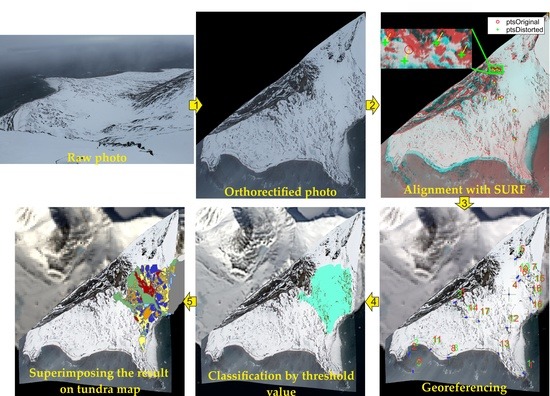Terrestrial Remote Sensing of Snowmelt in a Diverse High-Arctic Tundra Environment Using Time-Lapse Imagery
Abstract
:1. Introduction
2. Materials and Methods
2.1. Study Area
2.2. Data
2.3. Methods
2.3.1. Image Acquisition and Data Preprocessing
2.3.2. Orthorectification and Georectification
2.3.3. SCE Extraction
2.3.4. Spatial Analysis
3. Results
3.1. Snow Coverage in Fuglebekken Catchment
3.1.1. Snow Depth and Water Equivalent
3.1.2. SCE Evolution and Melt-Out Pattern
3.2. Relationship between Snow Cover and Vegetation
4. Discussion
5. Conclusions
Supplementary Materials
Acknowledgments
Author Contributions
Conflicts of Interest
References
- Evans, B.M.; Walker, D.A.; Benson, C.S.; Nordstrand, E.A.; Petersen, G.W. Spatial interrelationships between terrain, snow distribution and vegetation patterns at an arctic foothills site in Alaska. Ecography 1989, 12, 270–278. [Google Scholar] [CrossRef]
- Callaghan, T.V.; Johansson, M.; Brown, R.D.; Groisman, P.Y.; Labba, N.; Radionov, V.; Bradley, R.S.; Blangy, S.; Bulygina, O.N.; Christensen, T.R.; et al. Multiple Effects of Changes in Arctic Snow Cover. AMBIO 2011, 40, 32–45. [Google Scholar] [CrossRef]
- Jonas, T.; Rixen, C.; Sturm, M.; Stoeckli, V. How alpine plant growth is linked to snow cover and climate variability. J. Geophys. Res. 2008, 113. [Google Scholar] [CrossRef]
- Wahren, C.-H.A.; Walker, M.D.; Bret-Harte, M.S. Vegetation responses in Alaskan arctic tundra after 8 years of a summer warming and winter snow manipulation experiment. Glob. Change Biol. 2005, 11, 537–552. [Google Scholar] [CrossRef]
- Wipf, S. Phenology, growth, and fecundity of eight subarctic tundra species in response to snowmelt manipulations. Plant Ecol. 2010, 207, 53–66. [Google Scholar] [CrossRef]
- Cooper, E.J.; Dullinger, S.; Semenchuk, P. Late snowmelt delays plant development and results in lower reproductive success in the High Arctic. Plant Sci. 2011, 180, 157–167. [Google Scholar] [CrossRef] [PubMed]
- Johansson, M.; Callaghan, T.V.; Bosiö, J.; Åkerman, H.J.; Jackowicz-Korczynski, M.; Christensen, T.R. Rapid responses of permafrost and vegetation to experimentally increased snow cover in sub-arctic Sweden. Environ. Res. Lett. 2013, 8, 035025. [Google Scholar] [CrossRef]
- Hülber, K.; Bardy, K.; Dullinger, S. Effects of snowmelt timing and competition on the performance of alpine snowbed plants. Perspect. Plant Ecol. Evol. Syst. 2011, 13, 15–26. [Google Scholar] [CrossRef]
- Williams, C.M.; Henry, H.A.L.; Sinclair, B.J. Cold truths: how winter drives responses of terrestrial organisms to climate change: Organismal responses to winter climate change. Biol. Rev. 2015, 90, 214–235. [Google Scholar] [CrossRef] [PubMed]
- Wipf, S.; Rixen, C. A review of snow manipulation experiments in Arctic and alpine tundra ecosystems. Polar Res. 2010, 29, 95–109. [Google Scholar] [CrossRef]
- Anderson, K.; Gaston, K.J. Lightweight unmanned aerial vehicles will revolutionize spatial ecology. Front. Ecol. Environ. 2013, 11, 138–146. [Google Scholar] [CrossRef]
- Gisnås, K.; Westermann, S.; Schuler, T.V.; Litherland, T.; Isaksen, K.; Boike, J.; Etzelmüller, B. A statistical approach to represent small-scale variability of permafrost temperatures due to snow cover. Cryosphere 2014, 8, 2063–2074. [Google Scholar] [CrossRef]
- Winther, J.-G.; Godtliebsen, F.; Gerland, S.; Isachsen, P.E. Surface albedo in Ny-Ålesund, Svalbard: variability and trends during 1981–1997. Glob. Planet. Change 2002, 32, 127–139. [Google Scholar] [CrossRef]
- Luks, B. Dynamika zmian pokrywy śnieżnej w rejonie południowo-zachodniego Spitsbergenu. Ph.D. Dissertation, Institute of Geophysics, Polish Academy of Sciences, Warszawa, Poland, 2012. [Google Scholar]
- Johansen, B.E.; Karlsen, S.R.; Tømmervik, H. Vegetation mapping of Svalbard utilising Landsat TM/ETM+ data. Polar Rec. 2012, 48, 47–63. [Google Scholar] [CrossRef]
- Johansen, B.; Tømmervik, H. The relationship between phytomass, NDVI and vegetation communities on Svalbard. Int. J. Appl. Earth Obs. Geoinformation 2014, 27, 20–30. [Google Scholar] [CrossRef]
- Karlsen, S.; Elvebakk, A.; Høgda, K.; Grydeland, T. Spatial and Temporal Variability in the Onset of the Growing Season on Svalbard, Arctic Norway — Measured by MODIS-NDVI Satellite Data. Remote Sens. 2014, 6, 8088–8106. [Google Scholar] [CrossRef]
- Vickers, H.; Høgda, K.A.; Solbø, S.; Karlsen, S.R.; Tømmervik, H.; Aanes, R.; Hansen, B.B. Changes in greening in the high Arctic: insights from a 30 year AVHRR max NDVI dataset for Svalbard. Environ. Res. Lett. 2016, 11, 105004. [Google Scholar] [CrossRef]
- Parajka, J.; Haas, P.; Kirnbauer, R.; Jansa, J.; Blöschl, G. Potential of time-lapse photography of snow for hydrological purposes at the small catchment scale. Hydrol. Process. 2012, 26, 3327–3337. [Google Scholar] [CrossRef]
- Garvelmann, J.; Pohl, S.; Weiler, M. From observation to the quantification of snow processes with a time-lapse camera network. Hydrol. Earth Syst. Sci. 2013, 17, 1415–1429. [Google Scholar] [CrossRef]
- Smith, K.L.; Baldwin, R.J.; Glatts, R.C.; Chereskin, T.K.; Ruhl, H.; Lagun, V. Weather, ice, and snow conditions at Deception Island, Antarctica: long time-series photographic monitoring. Deep Sea Res. Part II Top. Stud. Oceanogr. 2003, 50, 1649–1664. [Google Scholar] [CrossRef]
- Hinkler, J.; Ørbæk, J.B.; Hansen, B.U. Detection of spatial, temporal, and spectral surface changes in the Ny-Ålesund area 79° N, Svalbard, using a low cost multispectral camera in combination with spectroradiometer measurements. Phys. Chem. Earth Parts ABC 2003, 28, 1229–1239. [Google Scholar] [CrossRef]
- Buus-Hinkler, J.; Hansen, B.U.; Tamstorf, M.P.; Pedersen, S.B. Snow-vegetation relations in a High Arctic ecosystem: Inter-annual variability inferred from new monitoring and modeling concepts. Remote Sens. Environ. 2006, 105, 237–247. [Google Scholar] [CrossRef]
- Laffly, D.; Bernard, E.; Griselin, M.; Tolle, F.; Friedt, J.-M.; Martin, G.; Marlin, C. High temporal resolution monitoring of snow cover using oblique view ground-based pictures. Polar Rec. 2012, 48, 11–16. [Google Scholar] [CrossRef]
- Bernard, É.; Friedt, J.-M.; Tolle, F.; Griselin, M.; Martin, G.; Laffly, D.; Marlin, C. Monitoring seasonal snow dynamics using ground based high resolution photography (Austre Lovenbreen, Svalbard, 79 N). ISPRS J. Photogramm. Remote Sens. 2013, 75, 92–100. [Google Scholar] [CrossRef]
- Hagen, D.; Vistad, O.; Eide, N.E.; Flyen, A.; Fangel, K. Managing visitor sites in Svalbard: from a precautionary approach towards knowledge-based management. Polar Res. 2012, 31, 18432. [Google Scholar] [CrossRef]
- Chang, M.; Bonnet, P. Monitoring in a High-Arctic Environment: Some Lessons from MANA. IEEE Pervasive Comput. 2010, 9, 16–23. [Google Scholar] [CrossRef]
- Vogel, S.W. Usage of high-resolution Landsat 7 band 8 for single-band snow-cover classification. Ann. Glaciol. 2002, 34, 53–57. [Google Scholar] [CrossRef]
- Cortés, G.; Girotto, M.; Margulis, S.A. Analysis of sub-pixel snow and ice extent over the extratropical Andes using spectral unmixing of historical Landsat imagery. Remote Sens. Environ. 2014, 141, 64–78. [Google Scholar] [CrossRef]
- Vikhamar, D.; Solberg, R. Snow-cover mapping in forests by constrained linear spectral unmixing of MODIS data. Remote Sens. Environ. 2003, 88, 309–323. [Google Scholar] [CrossRef]
- Grenfell, T.C.; Perovich, D.K. Seasonal and spatial evolution of albedo in a snow-ice-land-ocean environment. J. Geophys. Res. 2004, 109. [Google Scholar] [CrossRef]
- Lynch, A.H.; McGinnis, D.L.; Bailey, D.A. Snow-albedo feedback and the spring transition in a regional climate system model: Influence of land surface model. J. Geophys. Res. Atmospheres 1998, 103, 29037–29049. [Google Scholar] [CrossRef]
- Chapin, F.S.; Sturm, M.; Serreze, M.C.; McFadden, J.P.; Key, J.R.; Lloyd, A.H.; McGuire, A.D.; Rupp, T.S.; Lynch, A.H.; Schimel, J.P.; et al. Role of land-surface changes in Arctic summer warming. Science 2005, 310, 657–660. [Google Scholar] [CrossRef]
- Westermann, S.; Lüers, J.; Langer, M.; Piel, K.; Boike, J. The annual surface energy budget of a high-arctic permafrost site on Svalbard, Norway. The Cryosphere 2009, 3, 245–263. [Google Scholar] [CrossRef]
- Zhang, T. Influence of the seasonal snow cover on the ground thermal regime: An overview. Rev. Geophys. 2005, 43. [Google Scholar] [CrossRef]
- Dolnicki, P.; Grabiec, M.; Puczko, D.; Gawor, Ł.; Budzik, T.; Klementowski, J. Variability of temperature and thickness of permafrost active layer at coastal sites of Svalbard. Pol. Polar Res. 2013, 34, 353–374. [Google Scholar] [CrossRef]
- Wawrzyniak, T.; Osuch, M.; Napiórkowski, J.; Westermann, S. Modelling of the thermal regime of permafrost during 1990–2014 in Hornsund, Svalbard. Pol. Polar Res. 2016, 37, 219–242. [Google Scholar] [CrossRef]
- Roesch, A. Evaluation of surface albedo and snow cover in AR4 coupled climate models. J. Geophys. Res. 2006, 111. [Google Scholar] [CrossRef]
- Rechid, D.; Hagemann, S.; Jacob, D. Sensitivity of climate models to seasonal variability of snow-free land surface albedo. Theor. Appl. Climatol. 2009, 95, 197–221. [Google Scholar] [CrossRef]
- Pimentel, R.; Herrero, J.; Polo, M.J. Subgrid parameterization of snow distribution at a Mediterranean site using terrestrial photography. Hydrol. Earth Syst. Sci. 2017, 21, 805–820. [Google Scholar] [CrossRef]
- Karczewski, A.; Kostrzewski, A.; Marks, L. Raised marine terraces in the Hornsund area (northern part), Spitsbergen. Pol. Polar Res. 1981, 1, 39–50. [Google Scholar]
- Wojtuń, B.; Samecka-Cymerman, A.; Kolon, K.; Kempers, A.J.; Skrzypek, G. Metals in some dominant vascular plants, mosses, lichens, algae, and the biological soil crust in various types of terrestrial tundra, SW Spitsbergen, Norway. Polar Biol. 2013, 36, 1799–1809. [Google Scholar] [CrossRef]
- Marsz, A.A.; Styszyńska, A. Climate and climate change at Hornsund, Svalbard; Gdynia Maritime University: Gdynia, Poland, 2013. [Google Scholar]
- Łupikasza, E. Zmienność występowania opadów deszczu i śniegu w Hornsundzie w okresie lipiec 1978-grudzień 2002. Probl. Klimatol. Polarnej 2003, 13, 93–105. [Google Scholar]
- Miętus, M. Snow depth at the Hornsund Station, Spitsbergen in 1978-1986. Pol. Polar Res. 1991, 12, 223–228. [Google Scholar]
- Førland, E.J.; Benestad, R.; Hanssen-Bauer, I.; Haugen, J.E.; Skaugen, T.E. Temperature and Precipitation Development at Svalbard 1900–2100. Adv. Meteorol. 2011, 2011, 1–14. [Google Scholar] [CrossRef]
- Caputa, Z.; Leszkiewicz, J. Klasyfikacja zim w polskiej stacji polarnej w Hornsundzie (SW Spitsbergen) w okresie 1978/1979-2014/2015. Probl. Klimatol. Polarnej 2015, 25, 169–178. [Google Scholar]
- Migała, K.; Wojtuń, B.; Szymański, W.; Muskała, P. Soil moisture and temperature variation under different types of tundra vegetation during the growing season: A case study from the Fuglebekken catchment, SW Spitsbergen. CATENA 2014, 116, 10–18. [Google Scholar] [CrossRef]
- Szymański, W.; Wojtuń, B.; Stolarczyk, M.; Siwek, J.; Waścińska, J. Organic carbon and nutrients (N, P) in surface soil horizons in a non-glaciated catchment, SW Spitsbergen. Pol. Polar Res. 2016, 37, 49–66. [Google Scholar]
- Elvebakk, A. A survey of plant associations and alliances from Svalbard. J. Veg. Sci. 1994, 5, 791–802. [Google Scholar] [CrossRef]
- Walker, D.A.; Billings, W.D.; De Molenaar, J.G. Snow-vegetation interactions in tundra environments. In Snow Ecology: An Interdisciplinary Examination of Snow-Covered Ecosystems; Jones, H.G., Pomeroy, J.W., Walker, D.A., Hoham, R.W., Eds.; Cambridge University Press: New York, NY, USA, 2001; pp. 266–324. [Google Scholar]
- Skrzypek, G.; Wojtuń, B.; Richter, D.; Jakubas, D.; Wojczulanis-Jakubas, K.; Samecka-Cymerman, A. Diversification of Nitrogen Sources in Various Tundra Vegetation Types in the High Arctic. PLoS ONE 2015, 10. [Google Scholar] [CrossRef]
- Borysiak, J.; Ratyńska, H. Stan badań nad szatą roślinną Spitsbergenu ze szczególnym uwzględnieniem rejonów Bellsundu, Hornsundu i Kaffiøyry. In Warsztaty Glacjologiczne SPITSBERGEN 2004. Glacjologia, Geomorfologia I Sedymentologia środowiska Polarnego Spitsbergenu; Stowarzyszenie Geomorfologów Polskich: Poznań, Poland, 2004; pp. 248–260. [Google Scholar]
- Isaksen, K. The breeding population of little auk (Alle alle) in colonies in Hornsund and northwestern Spitsbergen. In Seabird population in the northern Barents Sea; Isaksen, K., Bakken, V., Eds.; Norsk Polarinstitutt: Oslo, Norway, 1995; pp. 49–57. [Google Scholar]
- Kwasniewski, S.; Gluchowska, M.; Jakubas, D.; Wojczulanis-Jakubas, K.; Walkusz, W.; Karnovsky, N.; Blachowiak-Samolyk, K.; Cisek, M.; Stempniewicz, L. The impact of different hydrographic conditions and zooplankton communities on provisioning Little Auks along the West coast of Spitsbergen. Prog. Oceanogr. 2010, 87, 72–82. [Google Scholar] [CrossRef]
- Guide to Meteorological Instruments and Methods of Observation WMO-No. 8. Available online: https://www.wmo.int/pages/prog/gcos/documents/gruanmanuals/CIMO/CIMO_Guide-7th_Edition-2008.pdf (accessed on 14 July 2017).
- Norwegian Polar Institute Terrengmodell Svalbard (S0 Terrengmodell); Norwegian Polar Institute: 2014. Available online: https://doi.org/10.21334/npolar.2014.dce53a47 (accessed on 9 April 2017).
- Kolondra, L. Polish Polar Station and Surrounding Areas, Spitsbergen. Orthophotomap 1: 5 000; Katowice Government: Katowice, Poland, 2003.
- Time-Lapse Camera Package|Products|Harbortronics. Available online: https://www.harbortronics.com/Products/TimeLapsePackage/ (accessed on 14 July 2017).
- Camera Calibration Toolbox for Matlab. Available online: http://www.vision.caltech.edu/bouguetj/calib_doc/ (accessed on 29 May 2017).
- Bay, H.; Ess, A.; Tuytelaars, T.; Van Gool, L. Speeded-up robust features (SURF). Comput. Vis. Image Underst. 2008, 110, 346–359. [Google Scholar] [CrossRef]
- Affek, A. Georeferencing of historical maps using GIS, as exemplified by the Austrian Military Surveys of Galicia. Geogr. Pol. 2013, 86, 375–390. [Google Scholar] [CrossRef]
- Fundamentals of georeferencing a raster dataset—Help|ArcGIS Desktop. Available online: http://desktop.arcgis.com/en/arcmap/latest/manage-data/raster-and-images/fundamentals-for-georeferencing-a-raster-dataset.htm (accessed on 9 April 2017).
- Salvatori, R.; Plini, P.; Giusto, M.; Valt, M.; Salzano, R.; Montagnoli, M.; Cagnati, A.; Crepaz, G.; Sigismondi, D. Snow cover monitoring with images from digital camera systems. Ital. J. Remote Sens. 2011, 137–145. [Google Scholar] [CrossRef]
- Härer, S.; Bernhardt, M.; Corripio, J.G.; Schulz, K. Practise–photo rectification and classification software (v. 1.0). Geosci. Model Dev. 2013, 6, 837–848. [Google Scholar] [CrossRef]
- Kabacoff, R. Analysis of variance. In R in Action: Data Analysis and Graphics with R; Stirling, S., Welch, L., Eds.; Manning Publications Co.: Shelter Island, USA, 2015. [Google Scholar]
- Abdi, H.; Williams, L.J. Tukey’s honestly significant difference (HSD) test. Encycl. Res. Des. 2010, 1, 1–5. [Google Scholar]
- Williamson, D.F.; Parker, R.A.; Kendrick, J.S. The box plot: a simple visual method to interpret data. Ann. Intern. Med. 1989, 110, 916–921. [Google Scholar] [CrossRef] [PubMed]
- Łaszyca, E.; Perchaluk, J.; Wawrzyniak, T. Meteorological Bulletin. Spitsbergen - Hornsund. May 2015. Available online: http://hornsund.igf.edu.pl/Biuletyny/BIULETYN_37/report_2015_05.pdf (accessed on 14 July 2017).
- Janiszewski, F. Instrukcja dla stacji meteorologicznych; Wydawnictwa Komunikacji i Lączności: Warszawa, Poland, 1962; ISBN 978-83-220-0329-9. [Google Scholar]
- Snow Measurement Guidelines for National Weather Service Surface Observing Programs. Available online: http://www.nws.noaa.gov/os/coop/reference/Snow_Measurement_Guidelines.pdf (accessed on 14 July 2017).
- Ferdynus, J.; Styszyńska, A. Temperatura powietrza a kierunek wiatru w Hornsundzie (1978-2009). Probl. Klimatol. Polarnej 2011, 21, 197–211. [Google Scholar]
- Dolnicki, P. Wplyw pokrywy śnieżnej na termikę i grubość warstwy czynnej zmarzliny w obszarze tundrowym rejonu Polskiej Stacji Polarnej (SW Spitsbergen). Probl. Klimatol. Polarnej 2002, 12, 107–116. [Google Scholar]
- Dolnicki, P. Zmienna grubość pokrywy śnieżnej na tundrze jako przyczyna zróżnicowania przestrzennego grubości warstwy czynnej na przykładzie wschodniej Fuglebergsletty (SW Spitsbergen). Probl. Klimatol. Polarnej 2015, 25, 191–200. [Google Scholar]
- Migała, K.; Pereyma, J.; Sobik, M. Akumulacja śnieżna na południowym Spitsbergenie. In Wyprawy Polarne Uniwersytetu Ślaskiego 1980-1984; Bajerowa, I., Ed.; Uniwersytet Śląski: Katowice, Poland, 1988; pp. 48–63. [Google Scholar]
- Węgrzyn, M.; Wietrzyk, P. Phytosociology of snowbed and exposed ridge vegetation of Svalbard. Polar Biol. 2015, 38, 1905–1917. [Google Scholar] [CrossRef]
- Opała-Owczarek, M.; Pirożnikow, E.; Owczarek, P.; Szymański, W.; Luks, B.; Kępski, D.; Szymanowski, M.; Wojtuń, B.; Migała, K. The influence of abiotic factors on the growth of two vascular plant species (Saxifraga oppositifolia and Salix polaris) in the High Arctic. CATENA under review.
- Williams, C.J.; McNamara, J.P.; Chandler, D.G. Controls on the temporal and spatial variability of soil moisture in a mountainous landscape: the signature of snow and complex terrain. Hydrol. Earth Syst. Sci. 2009, 13, 1325–1336. [Google Scholar] [CrossRef]
- Hobbler, A. Thermal characteristics of tundra, based on satellite data (Fuglebekken Basin, SW Spitsbergen). Master’s Thesis, University of Wroclaw, Wrocław, Poland, 2011. [Google Scholar]
- Szymański, W.; Skiba, S.; Wojtuń, B. Distribution, genesis, and properties of Arctic soils: a case study from the Fuglebekken catchment, Spitsbergen. Pol. Polar Res. 2013, 34, 289–304. [Google Scholar] [CrossRef]
- Wawrzyniak, T.; Osuch, M.; Nawrot, A.; Napiorkowski, J.J. Run-off modelling in an Arctic unglaciated catchment (Fuglebekken, Spitsbergen). Ann. Glaciol. 2017, 1–11. [Google Scholar] [CrossRef]
- Polkowska, Ż.; Cichała-Kamrowska, K.; Ruman, M.; Kozioł, K.; Krawczyk, W.E.; Namieśnik, J. Organic Pollution in Surface Waters from the Fuglebekken Basin in Svalbard, Norwegian Arctic. Sensors 2011, 11, 8910–8929. [Google Scholar] [CrossRef] [PubMed]
- Opaliński, K.W. Primary production and organic matter destruction in Spitsbergen tundra. Pol. Polar Res. 1991, 12, 419–434. [Google Scholar]
- Owczarek, P.; Opała, M. Dendrochronology and extreme pointer years in the tree-ring record (AD 1951–2011) of polar willow from southwestern Spitsbergen (Svalbard, Norway). Geochronometria 2016, 43, 84–95. [Google Scholar] [CrossRef]


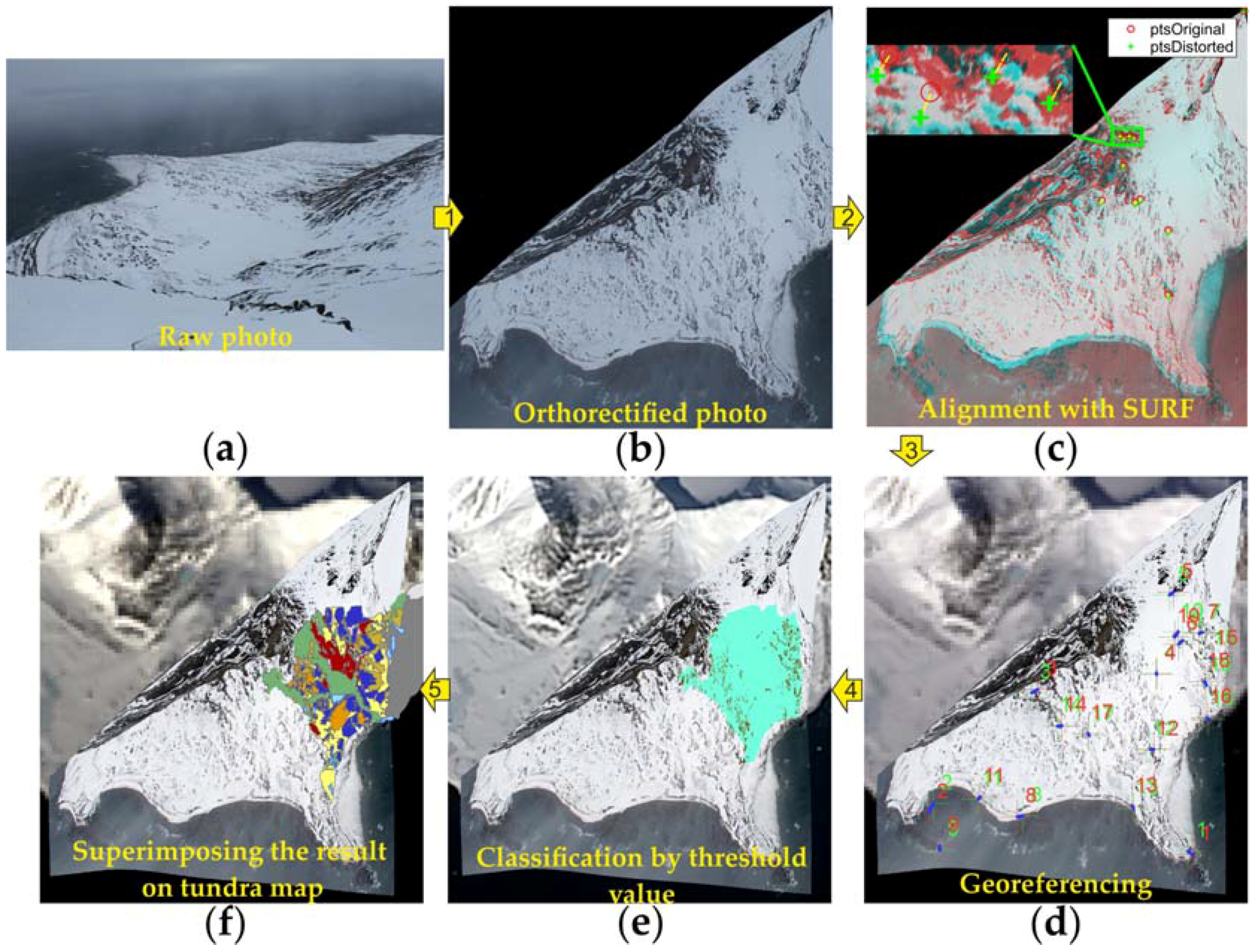
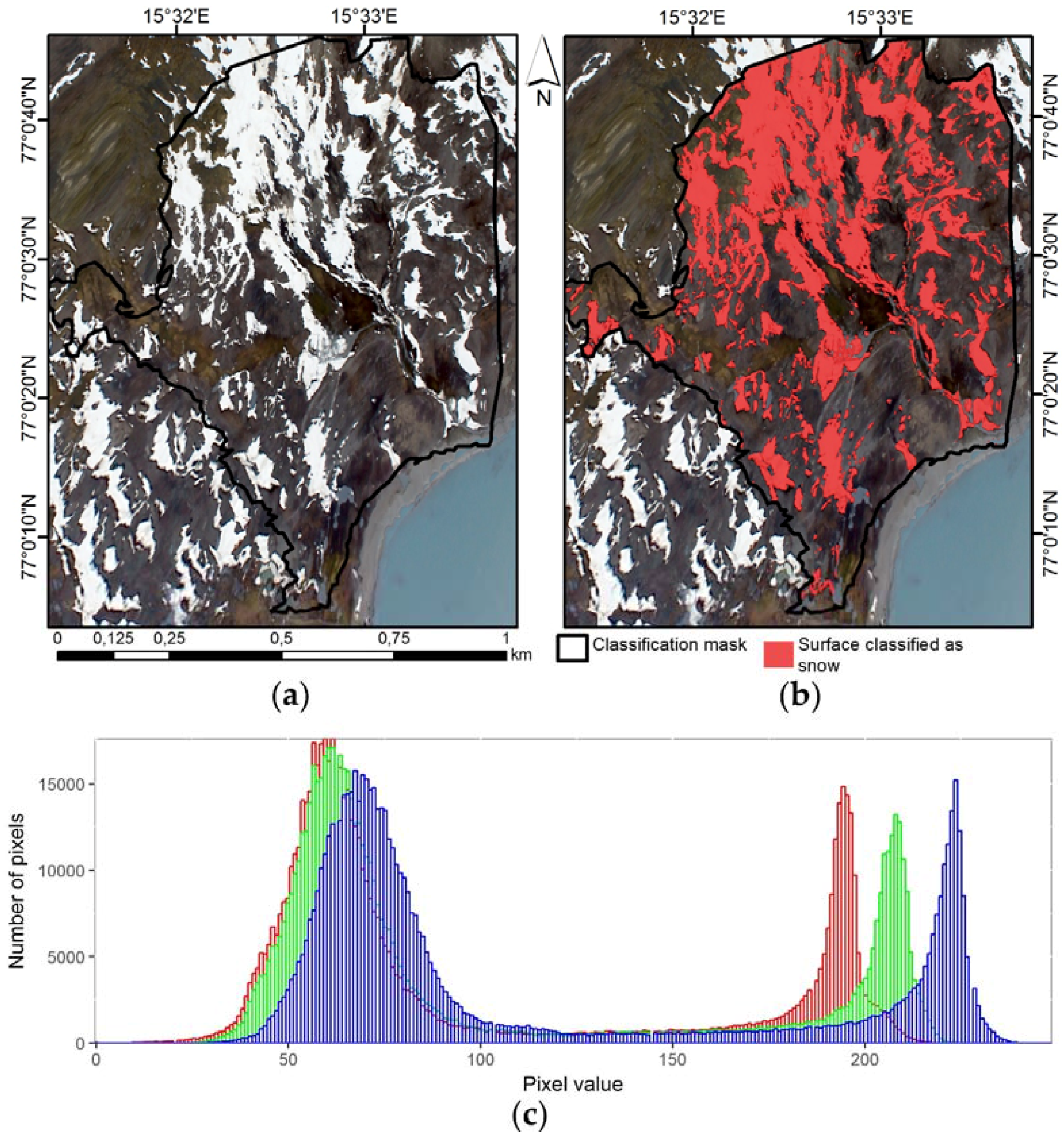
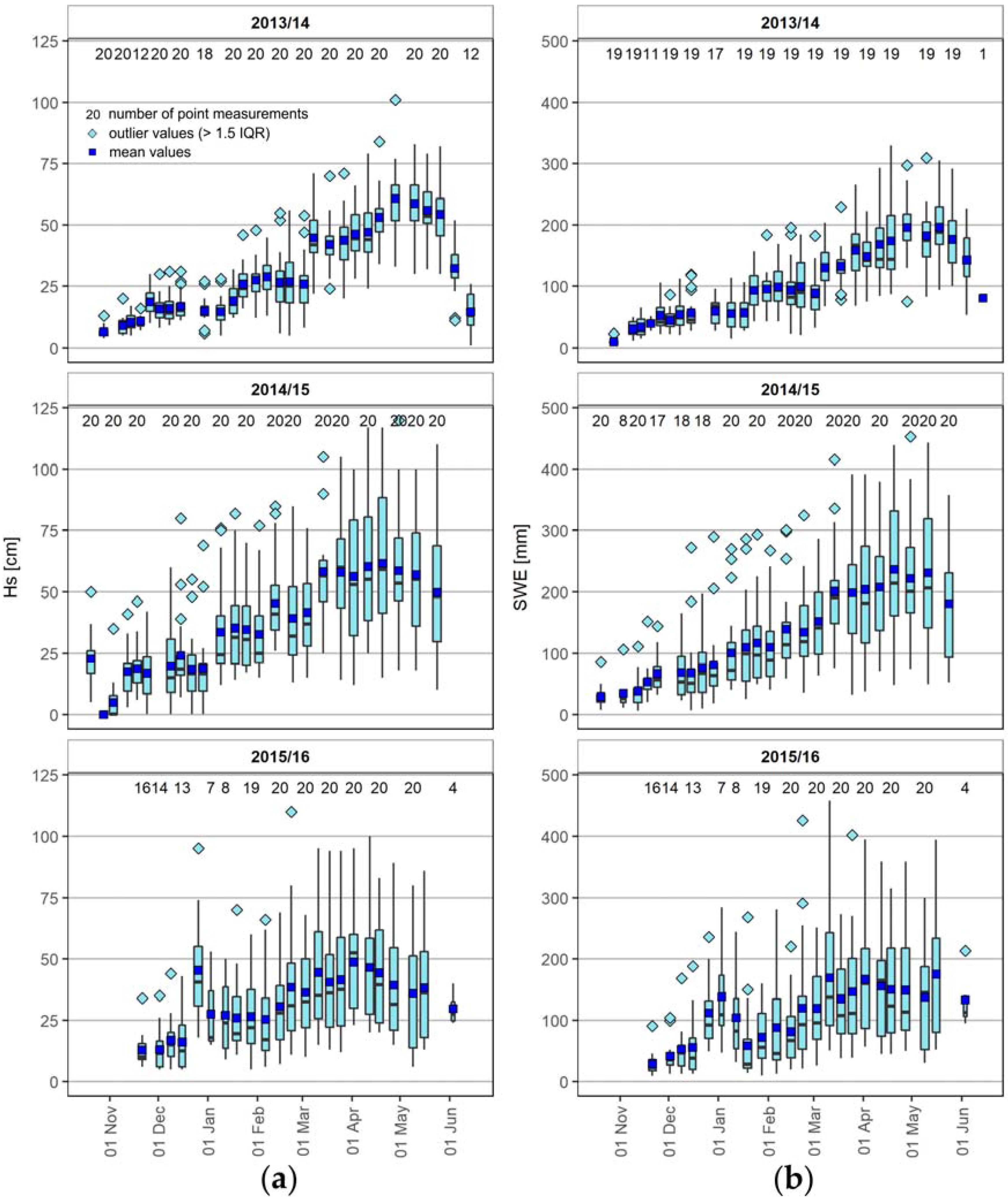
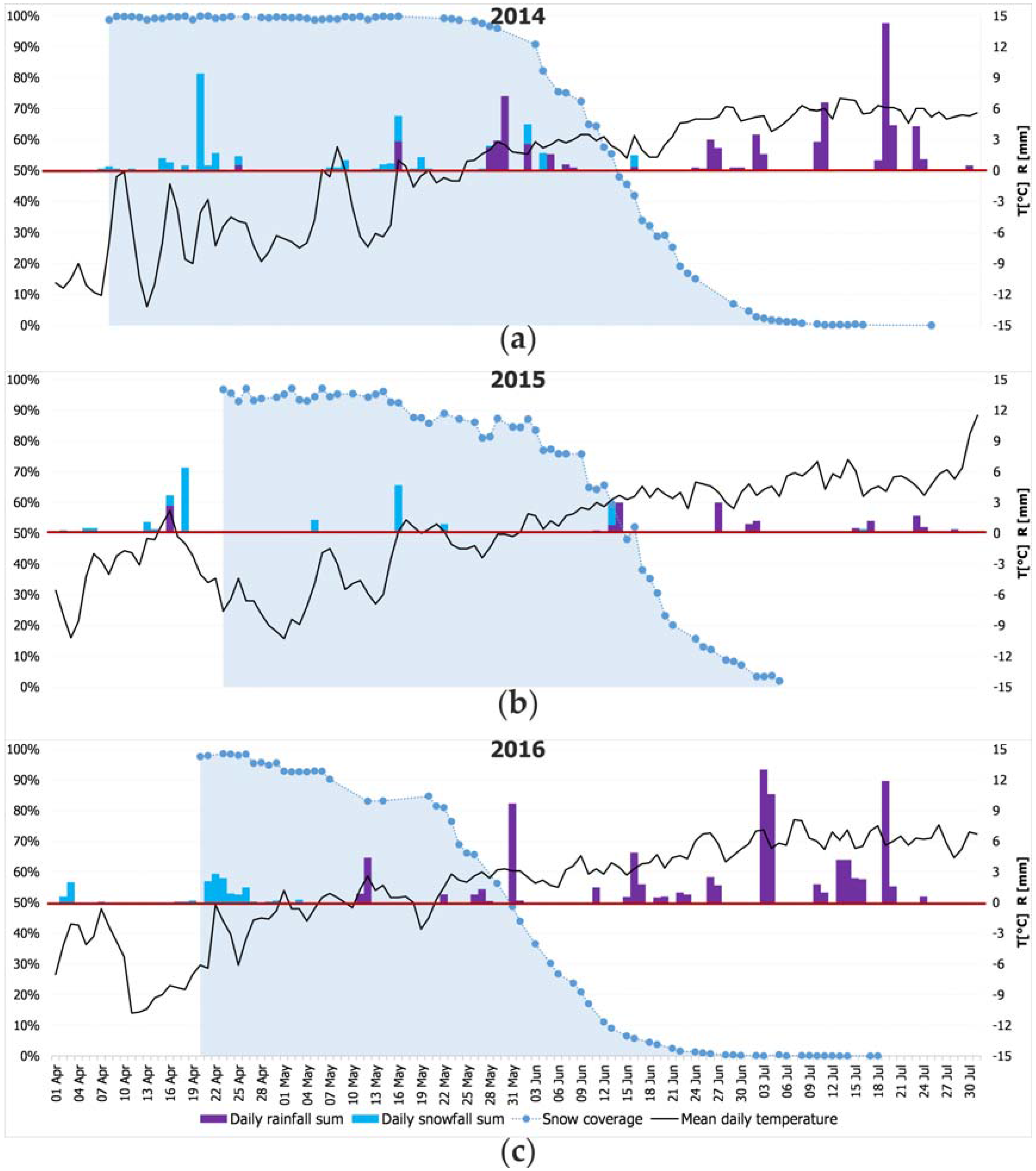
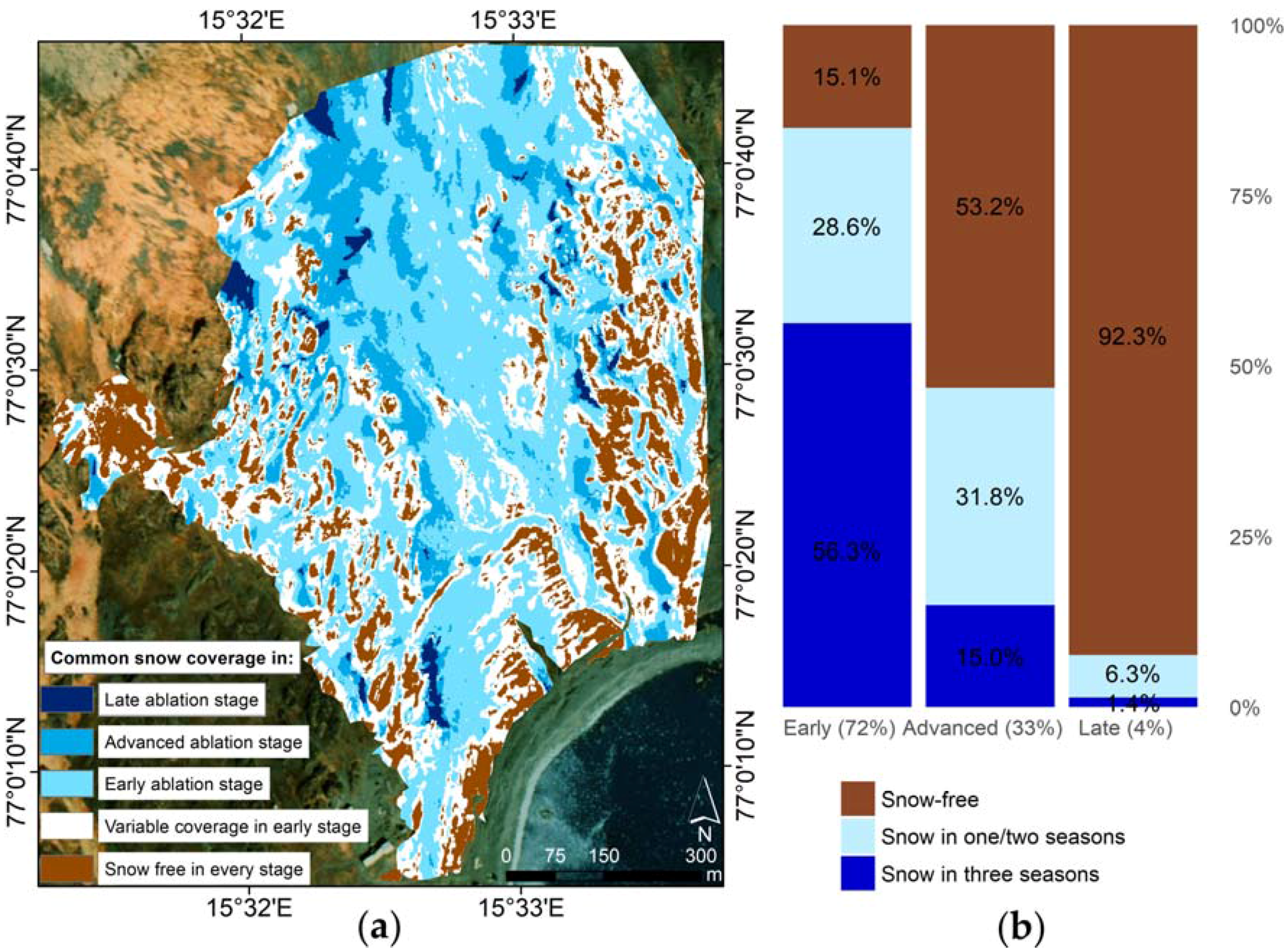

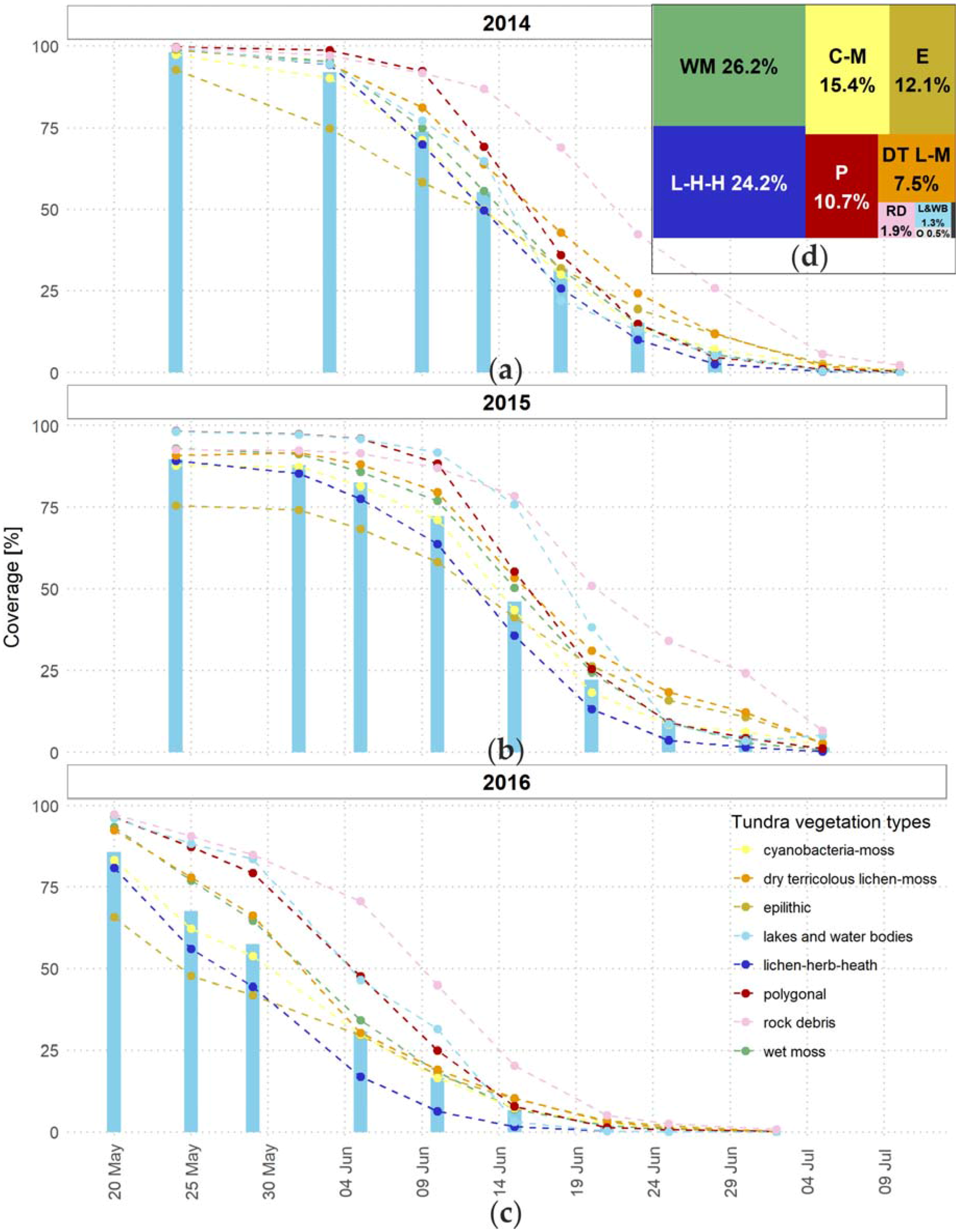
| Month | 2013/14 | 2014/15 | 2015/16 | 1978–2016 2 | ||||||||||||
|---|---|---|---|---|---|---|---|---|---|---|---|---|---|---|---|---|
| Mean T 1 (°C) | Total R 1 (mm) | % of Snowfall | Mean Hs 1 (cm) | Mean T (°C) | Total R (mm) | % of Snowfall | Mean Hs (cm) | Mean T (°C) | Total R (mm) | % of Snowfall | Mean Hs (cm) | Mean T (°C) | Total R (mm) | % of Snowfall | Mean Hs (cm) | |
| October | −2.7 | 34 | 82 | 5 | −0.3 | 65 | 66 | 6 | −0.2 | 93 | 56 | 1 | −2.8 | 52 | 66 | 3 |
| November | −6.1 | 27 | 89 | 7 | −4.4 | 38 | 71 | 5 | −2.4 | 39 | 73 | 4 | −6 | 40 | 79 | 7 |
| December | −6.0 | 25 | 81 | 10 | −7.6 | 9 | 100 | 8 | −4.6 | 45 | 75 | 13 | −8.9 | 33 | 88 | 11 |
| January | −3.0 | 32 | 75 | 12 | −5.9 | 19 | 89 | 9 | −2.4 | 45 | 74 | 10 | −9.9 | 34 | 88 | 17 |
| February | −0.9 | 8 | 93 | 20 | −11.3 | 49 | 88 | 15 | −3.9 | 16 | 100 | 11 | −10 | 28 | 91 | 22 |
| March | −6.8 | 54 | 91 | 34 | −5.3 | 40 | 93 | 23 | −5.5 | 44 | 80 | 13 | −10.2 | 30 | 90 | 26 |
| April | −7.3 | 17 | 96 | 37 | −4.2 | 13 | 97 | 17 | −5.0 | 4 | 100 | 21 | −8.1 | 22 | 89 | 29 |
| May | −1.9 | 23 | 72 | 38 | −2.8 | 8 | 99 | 10 | 1.0 | 30 | 71 | 9 | −2.6 | 22 | 81 | 25 |
| June | 3.3 | 17 | 16 | 4 | 2.9 | 9 | 12 | 2 | 3.8 | 17 | 2 | - | 2.1 | 27 | 23 | 7 |
| October–June | −3.5 | 236 | 78 | 18 | −4.3 | 249 | 82 | 11 | −2.1 | 332 | 72 | 10 | −7.2 | 260 | 79 | 15 |
| Equipment | Aperture | Focus | ISO Sensitivity | Shutter Speed | Capture Frequency | Focal Length |
|---|---|---|---|---|---|---|
| Canon EOS REBEL T3 (1200D) camera with Harbortronics DigiSnap 2000 intervalometer powered by 11.1 V 9000 mAh lithium polymer battery and 5 Watt solar panel 1 | f/8 | manual | 100 | Auto-mode | 1 h | 18–23 mm 2 |
| Year | Date of Initial Deployment | Date of Last Processed Picture | Number of Processed Pictures | Days between Dates (Demanded Amount of Pictures) | Date of Deinstallation |
|---|---|---|---|---|---|
| 2014 | 8 April | 25 July | 81 | 108 | 17 October |
| 2015 | 23 April | 5 July | 60 | 73 | 5 November 1 |
| 2016 | 20 April | 18 July | 62 | 89 | 29 July |
| Snow Coverage | Occurrence Time in 2014 | Days to Melt | Occurrence Time in 2015 | Days to Melt | Occurrence Time in 2016 | Days to Melt |
|---|---|---|---|---|---|---|
| 90% | 3 June | 30 | 17 May | 50 | 8 May | 45 |
| 75% | 5 June | 28 | 10 June | 26 | 24 May | 29 |
| 50% | 14 June | 19 | 15 June | 21 | 30 May | 23 |
| 25% | 21 June | 12 | 20 June | 16 | 7 June | 15 |
| 10% | 27 June | 6 | 27 June | 9 | 13 June | 9 |
| Total disappearance 1 | 3 July | 0 | 6 July | 0 | 22 June | 0 |
| Type 1 | Type 2 | Mean Difference (cm) | Lower End Point of Confidence Interval (cm) | Upper End Point of Confidence Interval (cm) | p Value |
|---|---|---|---|---|---|
| wet moss tundra | Rock debris | +7.9 | +3.4 | +12.4 | 0.0000219 |
| wet moss tundra | polygonal tundra | +4.2 | +1.6 | +6.7 | 0.0000833 |
| wet moss tundra | cyanobacteria-moss tundra | +6.2 | +1.7 | +10.6 | 0.0014096 |
| wet moss tundra | lichen-herb-heath tundra | +4.2 | +0.6 | +7.8 | 0.0136878 |
© 2017 by the authors. Licensee MDPI, Basel, Switzerland. This article is an open access article distributed under the terms and conditions of the Creative Commons Attribution (CC BY) license (http://creativecommons.org/licenses/by/4.0/).
Share and Cite
Kępski, D.; Luks, B.; Migała, K.; Wawrzyniak, T.; Westermann, S.; Wojtuń, B. Terrestrial Remote Sensing of Snowmelt in a Diverse High-Arctic Tundra Environment Using Time-Lapse Imagery. Remote Sens. 2017, 9, 733. https://doi.org/10.3390/rs9070733
Kępski D, Luks B, Migała K, Wawrzyniak T, Westermann S, Wojtuń B. Terrestrial Remote Sensing of Snowmelt in a Diverse High-Arctic Tundra Environment Using Time-Lapse Imagery. Remote Sensing. 2017; 9(7):733. https://doi.org/10.3390/rs9070733
Chicago/Turabian StyleKępski, Daniel, Bartłomiej Luks, Krzysztof Migała, Tomasz Wawrzyniak, Sebastian Westermann, and Bronisław Wojtuń. 2017. "Terrestrial Remote Sensing of Snowmelt in a Diverse High-Arctic Tundra Environment Using Time-Lapse Imagery" Remote Sensing 9, no. 7: 733. https://doi.org/10.3390/rs9070733







